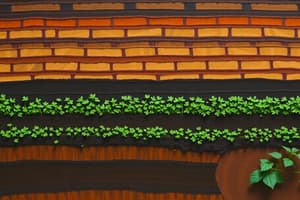Podcast
Questions and Answers
What is the primary role of soil in supporting life on Earth?
What is the primary role of soil in supporting life on Earth?
- It acts as a barrier against erosion.
- It provides a habitat for animals.
- It is a source of nutrients and water for plants. (correct)
- It serves as a layer for geological formations.
Which horizon is characterized by the incorporation of organic materials with mineral matter?
Which horizon is characterized by the incorporation of organic materials with mineral matter?
- Horizon B
- Horizon A (correct)
- Horizon D
- Horizon C
What primarily characterizes Horizon B in the soil profile?
What primarily characterizes Horizon B in the soil profile?
- It is devoid of any organic matter.
- It contains only mineral matter.
- It is composed entirely of parent rock.
- It is a transition zone with mixed materials. (correct)
What components make up the soil?
What components make up the soil?
What does the process of soil formation depend on?
What does the process of soil formation depend on?
Which layer of soil is the first stage in the soil formation process?
Which layer of soil is the first stage in the soil formation process?
What is the bedrock also referred to as?
What is the bedrock also referred to as?
Why is soil considered a valuable resource?
Why is soil considered a valuable resource?
What is another name for black soil?
What is another name for black soil?
Which of the following characteristics is true for black soil?
Which of the following characteristics is true for black soil?
In which geographical area is black soil predominantly found?
In which geographical area is black soil predominantly found?
What does the term 'laterite' derive from?
What does the term 'laterite' derive from?
Which factor heavily influences the formation of laterite soils?
Which factor heavily influences the formation of laterite soils?
How do alluvial soils primarily develop?
How do alluvial soils primarily develop?
What is a common characteristic of black soils during the dry season?
What is a common characteristic of black soils during the dry season?
Which state is NOT mentioned as part of the black soil region?
Which state is NOT mentioned as part of the black soil region?
Which soil type accounts for the largest area in India according to the USDA soil taxonomy?
Which soil type accounts for the largest area in India according to the USDA soil taxonomy?
Which soil is characterized as the 'new alluvium' that is deposited by floods annually?
Which soil is characterized as the 'new alluvium' that is deposited by floods annually?
What is the primary nutrient that alluvial soils are rich in?
What is the primary nutrient that alluvial soils are rich in?
Which of these soil types is least represented in terms of area in India?
Which of these soil types is least represented in terms of area in India?
What texture do Khadar and Bhangar soils primarily have in the lower and middle Ganga plain?
What texture do Khadar and Bhangar soils primarily have in the lower and middle Ganga plain?
Which of the following soil types is described as older alluvium and deposited away from the flood plains?
Which of the following soil types is described as older alluvium and deposited away from the flood plains?
How does the sand content of soils change geographically across India?
How does the sand content of soils change geographically across India?
What color variations do alluvial soils typically exhibit?
What color variations do alluvial soils typically exhibit?
What slope gradient is considered unsuitable for farming?
What slope gradient is considered unsuitable for farming?
Which method can help control the headward extension of gullies?
Which method can help control the headward extension of gullies?
What is a key remedial measure to protect cultivable lands from soil erosion?
What is a key remedial measure to protect cultivable lands from soil erosion?
What conservation strategy can be adopted to manage sand dune encroachment?
What conservation strategy can be adopted to manage sand dune encroachment?
Which of the following practices is NOT mentioned as a remedial measure against soil erosion?
Which of the following practices is NOT mentioned as a remedial measure against soil erosion?
What organization has prepared plans for soil conservation in India?
What organization has prepared plans for soil conservation in India?
In which regions should efforts be made to combat sand dune encroachment?
In which regions should efforts be made to combat sand dune encroachment?
What is a consequence of over-grazing and shifting cultivation?
What is a consequence of over-grazing and shifting cultivation?
What is indicated by the term 'badland topography'?
What is indicated by the term 'badland topography'?
Which region is noted for widespread ravines?
Which region is noted for widespread ravines?
Approximately how much land does India lose to ravines each year?
Approximately how much land does India lose to ravines each year?
What contributes to soil degradation and loss of nutrients in India?
What contributes to soil degradation and loss of nutrients in India?
Which approach is crucial for maintaining soil fertility?
Which approach is crucial for maintaining soil fertility?
Which of the following is a common cause of aggravating soil erosion?
Which of the following is a common cause of aggravating soil erosion?
What is the impact of deep gullies on agricultural lands?
What is the impact of deep gullies on agricultural lands?
What is a natural process that balances ecological systems?
What is a natural process that balances ecological systems?
Flashcards are hidden until you start studying
Study Notes
Importance of Soil
- Soil is essential for sustaining trees, grasses, and various life forms.
- Forms the basis for agriculture, influencing the growth of crops and provision of clothing materials.
- Composed of rock debris and organic materials, evolving over thousands of years.
- Major components include minerals, humus, water, and air.
- Formation influenced by relief, parent material, climate, vegetation, time, and human activities.
Soil Horizons
- Horizon A: The topmost layer, rich in organic matter mixed with minerals, essential for plant growth.
- Horizon B: Transitional layer with derived matter from above and below, contains some organic matter but primarily mineral material.
- Horizon C: Composed of loose parent material, the starting point in soil formation.
- The arrangement of these layers creates what is called the soil profile, under which lies the bedrock.
Classification of Soils in India
- Classified based on USDA soil taxonomy into seven main orders:
- Inceptisols: 39.74% of area (130,372.90 thousand hectares)
- Entisols: 28.08% (92,131.71 thousand hectares)
- Alfisols: 13.55% (44,448.68 thousand hectares)
- Vertisols: 8.52% (27,960 thousand hectares)
- Aridisols: 4.28% (14,069 thousand hectares)
- Ultisols: 2.51% (8,250 thousand hectares)
- Mollisols: 0.40% (1,320 thousand hectares)
- Others: 2.92% (9,503.10 thousand hectares)
Types of Soils in India
- Alluvial Soils: Found in northern plains and river valleys; rich in nutrients, varies from sandy loam to clay.
- Black Soils: Known as 'Regur' or 'Black Cotton Soil', deep and clayey; prevalent in the Deccan Plateau and retains moisture, leading to suitable cotton cultivation.
- Red and Yellow Soils: Formed in areas with little rain; generally less fertile.
- Laterite Soils: Derived from intense leaching; found in high-temperature areas with high rainfall, resulting in brick-like features.
- Arid Soils: Found in dry regions; generally nutrient-poor.
- Saline Soils: High in salts, can be detrimental to plant growth.
- Peaty Soils: Rich in organic matter, usually saturated with water; found in wetlands.
- Forest Soils: Fertile soils found in forested regions.
Soil Erosion and Conservation
- Soil erosion is accelerated by poor agricultural practices, leading to land degradation.
- Estimated loss of 8,000 hectares annually due to ravines; affects national productivity.
- Soil Conservation Techniques:
- Avoid farming on steep slopes; land with 15-25% gradient should not be cultivated.
- Implement terracing on sloped lands and construct check dams to reduce erosion.
- Promote contour bunding, terracing, and regulated forestry to protect soil.
- Cultivation of cover crops and practicing mixed farming to preserve soil health.
- Convert non-arable lands into pastures to support grazing.
Initiatives for Soil Conservation
- Central Soil Conservation Board conducts studies and develops plans for sustainable practices based on local conditions.
- Efforts include stabilizing sand dunes and educating communities about soil conservation methods.
Studying That Suits You
Use AI to generate personalized quizzes and flashcards to suit your learning preferences.




